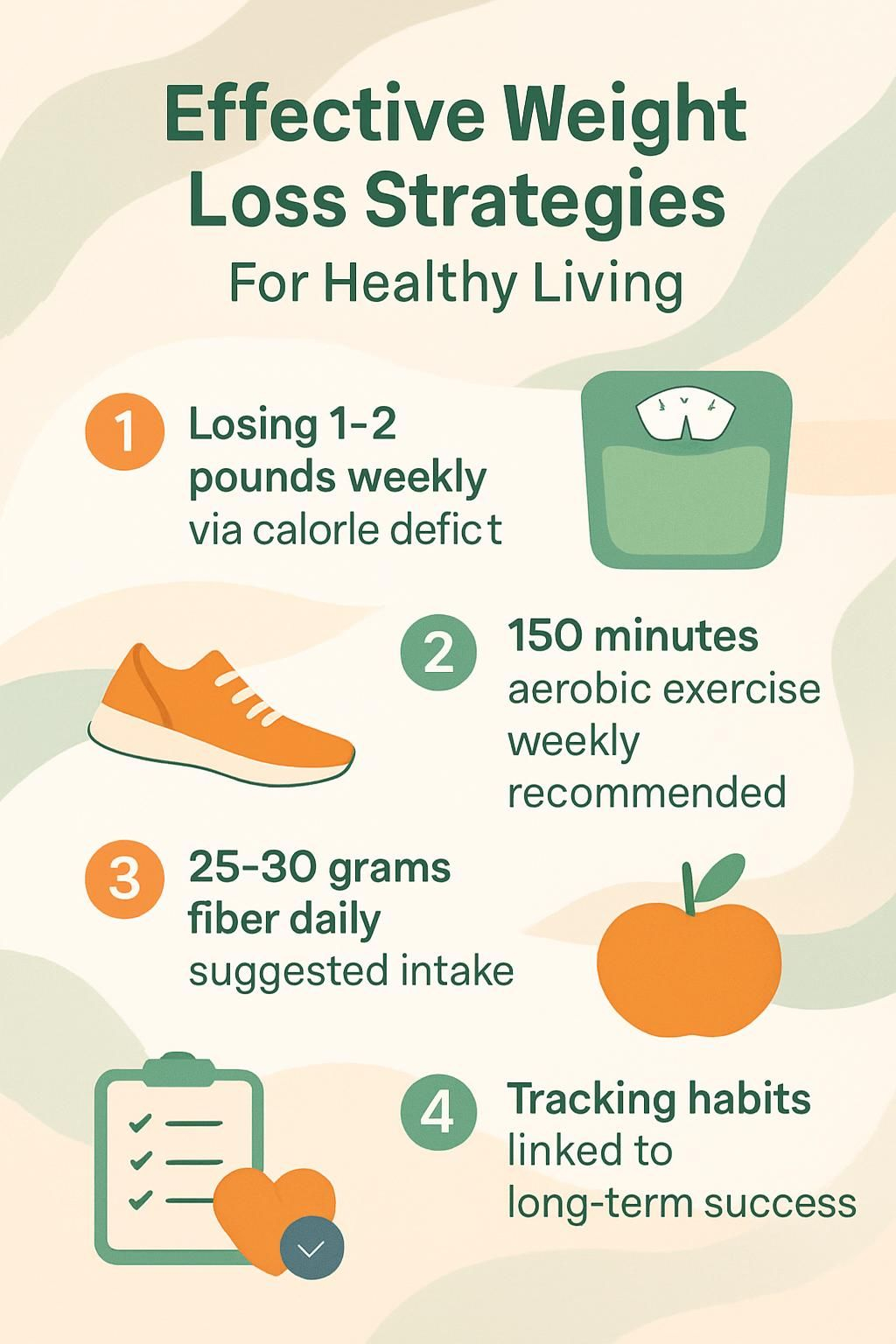Effective Weight Loss Strategies For Healthy Living
Our Nutrition Assistant AI Suite will transform your body. You will lose fat, get toned, and build muscle. Gain confidence and optimal health.
Weight loss can feel frustrating, especially after many diet plans that do not stick. If you want to lose weight and keep it off, a steady plan works better than quick fixes. Research from trusted groups like Mayo Clinic and the American Heart Association supports a simple approach built on food, movement, and habits.
This guide gives you clear steps, reasonable targets, and tools that fit daily life. You will learn how to set goals, track progress, and build routines that last. Use these ideas to improve your health at a pace that feels doable.
Key Takeaways
- A safe pace is 1 to 2 pounds per week, which usually means a daily calorie deficit of about 500 to 750, supported by Mayo Clinic, the CDC, and the Department of Health and Human Services.
- Combine 150 minutes of aerobic exercise each week with strength training twice weekly. This helps protect muscle while you lose body fat, as noted in American Heart Association guidance.
- Focus your diet on fiber, about 25 to 30 grams daily, and protein, about 20 to 30 grams per meal. Limit added sugars, choose whole foods, and lower chronic disease risk.
- Use food journals, activity tracking, mindful eating, and social support. Studies in JAMA Network Open and Obesity link these tools to long-term success.
- Medical options such as prescriptions or bariatric surgery may help if your BMI is 30 or higher, or 27 with conditions like diabetes, and if lifestyle changes alone do not lead to at least 5 percent weight loss after six months.

Understanding Weight Loss

Knowing how body weight affects health helps you make smart choices. A few simple measures show where you are starting and how to improve.
What Is a Healthy Weight?
A healthy weight fits your height, age, and body type. Health experts often use Body Mass Index, or BMI, a number based on weight and height. For most adults in the United States, a BMI from 18.5 to 24.9 is considered normal.
Waist size adds useful detail about body fat around your middle. Measure just above your hip bones with a soft tape. Many experts suggest a target under 35 inches for most women and under 40 inches for most men, based on Mayo Clinic guidance.
These tools help you monitor change during any weight-loss program. A quick check with the CDC’s online BMI calculator can show how small shifts in eating patterns and physical activity move the numbers in the right direction.
Why Is Weight Management Important?
Keeping a healthy body weight lowers risk for heart disease, type 2 diabetes, and high blood pressure. Even a modest change helps. Losing 5 percent of your starting weight can improve cholesterol and blood sugar.
For someone at 200 pounds, a 10 pound loss may reduce health risks and improve energy. Weight management also affects mood and daily function. Many factors can push weight up, including genetics, hormones, certain medicines, stress, poor sleep, medical conditions, and your food environment at home.
Even modest amounts of weight loss, such as five percent of total body weight, can improve cholesterol levels and blood sugar. (Department of Health and Human Services)
Before you act, get clear on your personal reasons for change. That focus keeps you going when life gets busy.
Setting the Foundation for Success
Lasting change starts with purpose and simple systems. Clear goals and regular tracking help you stick with healthy behavior over time.
How Do You Identify Your “Why” for Weight Loss?
List your main reasons to lose weight. Examples include lowering heart risk, feeling better for a trip, or keeping up with your kids. Post these reasons where you see them every day, like the fridge or bathroom mirror.
Use quick reminders, such as a note that says “One choice at a time.” The National Weight Control Registry reports that people who write down their reasons tend to maintain progress longer.
How Can You Track Your Starting Point?
Keep a daily food diary. Write down what you eat and drink, portion sizes, times, and mood. Patterns appear fast, such as late night snacking or sugar-heavy drinks.
Track activity with type, duration, and time of day. Note sleep hours and stress triggers. Add coping ideas like deep breathing, stretching, or a quick call with a friend. These notes show where to adjust before you start a new plan.
You cannot improve what you do not measure.
How Do You Set Realistic and Achievable Weight Loss Goals?
Aim to lose 1 to 2 pounds per week. That usually means a calorie deficit near 500 to 750 per day. Many clinicians suggest an initial target of about 5 percent of current body weight.
Break big goals into small actions you control. Try a 15 minute walk after dinner, or add one serving of vegetables at lunch. Avoid extreme targets like 20 pounds in two weeks. Those goals raise frustration and often lead to fast regain.
Dietary Approaches for Effective Weight Loss
Food choices drive weight management. A steady calorie deficit, built on nutrient-dense meals, supports safe fat loss and better health.
How Does Creating a Calorie Deficit Help with Weight Loss?
You lose weight when you eat fewer calories than you burn. A calorie deficit comes from eating less, moving more, or both. A daily gap of 500 to 750 calories supports steady fat loss without stripping muscle.
Count all foods and drinks. Check serving sizes because extra bites add up. A reduced calorie plan that favors whole foods, plus regular physical activity, is a core strategy recommended by the Department of Health and Human Services.
What Are Nutrient-Dense Foods to Choose?
Nutrient-dense foods deliver vitamins and minerals without many empty calories. Build most meals from these staples:
- Fill half your plate with vegetables each day. Try broccoli, spinach, carrots, peppers, or salad greens.
- Include two to three servings of fruit, such as berries, apples, or oranges.
- Pick whole grains like brown rice, quinoa, oats, or whole wheat bread.
- Choose lean proteins, for example chicken breast, fish, beans, tofu, or tempeh.
- Add healthy fats in small amounts, such as avocado, nuts, seeds, or olive oil.
- Use low fat or fat free dairy like skim milk or plain yogurt.
- Limit added sugars and highly processed foods to lower total calories.
Eating this way helps you feel satisfied and protects health while you lose weight.
How Can You Reduce Added Sugars and Processed Foods?
Cutting added sugars and processed foods reduces calories fast and supports better blood sugar control. Focus on simple swaps and label skills.
- Read labels and spot sugars like sucrose, corn syrup, or honey near the top of the ingredient list.
- Drink water or unsweetened tea instead of soda, energy drinks, or sweet coffee beverages.
- Cook at home with basic ingredients to control portions and quality.
- Snack on fruit, veggie sticks, nuts, or plain yogurt instead of chips or cookies.
- Save fast food for rare treats, since these meals often combine sugar, salt, and fat.
- Choose whole grain bread and cereals to boost fiber and fullness.
- Watch sauces and dressings, which often hide significant added sugars.
These changes lower cravings over time and make daily calories easier to manage.
Why Increase Fiber and Protein Intake?
Fiber slows digestion, so you feel full longer. It also supports healthy digestion. Good sources include beans, whole grains, fruit, and vegetables. The American Heart Association links higher fiber intake with lower body weight and reduced disease risk.
Protein helps protect muscle while you lose fat. Include a protein source at each meal and snack, such as eggs, fish, poultry, tofu, Greek yogurt, or beans. Balanced protein also steadies blood sugar, which can improve mood and focus.
- Daily fiber goal: 25 to 30 grams.
- Per meal protein goal: 20 to 30 grams.
Some plans, like ketogenic diets, limit carbohydrates and raise protein and fat. This can work for some people, though the rules are strict, so check with a clinician first. Studies suggest people who eat adequate protein and fiber keep lost weight off longer than those with lower intake, reported in JAMA Network Open in 2022.
How Much Water Should You Drink for Weight Loss?
Hydration helps control hunger and supports mindful eating. A simple target is eight 8 ounce glasses daily, about 2 liters. Drinking water instead of sugary beverages can cut hundreds of calories each day.
Try a glass before meals to tune in to real hunger. Some research suggests proper hydration may raise the calories you burn at rest, called resting energy expenditure. Replacing soda or juice with water several times a day supports steady progress.
Physical Activity for Weight Loss
Movement acts like a daily nudge for your metabolism. Regular physical activity also improves heart health and mood.
What Are the Benefits of Regular Exercise?
Consistent exercise helps you lose 1 to 2 pounds per week while protecting muscle. It supports healthy blood pressure, cholesterol, and blood sugar. It also lowers risk for heart disease and type 2 diabetes.
Exercise pairs well with healthy eating for long-term results. Many people notice more energy and better sleep after a few weeks. You do not need extreme workouts to see benefits.
How Do You Incorporate Aerobic Exercise into Your Routine?
Aerobic exercise, like brisk walking or cycling, raises your heart rate and burns calories. Simple planning makes it stick.
- Schedule at least 150 minutes of moderate aerobic activity each week.
- Split time into 30 minute sessions on most days for ease.
- Pick activities you enjoy, such as dancing or swimming.
- Walk short errands or park farther away to add steps.
- Choose stairs when possible to increase daily burn.
- Track time and distance with a watch or app.
- Invite a friend or family member for accountability.
- Use home videos or a gym if weather blocks outdoor options.
- Play music to keep pace and lift motivation.
- Celebrate non scale wins, like better stamina or mood.
Small, steady sessions add up and feel more realistic on busy days.
Why Is Strength Training Important for Muscle Maintenance?
Strength training protects muscle during weight loss. Use weights, machines, or resistance bands at least twice per week. This signals your body to preserve lean tissue while you reduce calories.
Muscle burns more calories at rest than fat. Keeping muscle helps your metabolism and makes daily tasks feel easier. People who combine strength and cardio often see better long-term weight control.
How Can You Add More Movement to Your Day?
Simple habits boost your daily burn without a formal workout.
- Take the stairs instead of the elevator.
- Park farther from doors at work or stores.
- Stand or walk during phone calls or TV breaks.
- Aim for 8,000 to 10,000 steps, using a pedometer or phone.
- Use public transit if possible to add natural walking.
- Bring fruit or nuts to avoid vending machines.
- Start a workplace walk group or wellness challenge.
- Schedule a lunch walk with a coworker to reduce stress.
- Set an hourly timer to stretch or move for two minutes.
These micro choices support steady results next to a planned exercise program.
Behavioral and Lifestyle Changes
Small daily habits shape long-term weight. A few mindset tools make healthy living feel more automatic.
What Is Mindful Eating and How Do You Practice It?
Mindful eating means paying attention to taste, sight, and smell during meals. Turn off screens and slow down. Notice hunger and fullness signs, then stop when satisfied, not stuffed.
Start with one meal a day. Sit at a table, chew well, and pause between bites. Many people find they eat fewer calories and enjoy food more when they eat this way.
How Can Keeping a Food and Weight Journal Help?
Writing down meals and snacks builds awareness and accountability. You see what helps and what gets in the way. In one study, people who kept daily records lost about twice as much as those who did not.
Logs reveal patterns like stress eating or skipping breakfast. Use that insight to adjust your plan and celebrate small wins, such as fewer sugary drinks or better portion control.
How Do Stress Management and Sleep Affect Weight Loss?
Short sleep raises hunger hormones and cravings for high calorie foods. Aim for seven to nine hours nightly. Limit late caffeine and set a steady bedtime to improve rest and mood.
Stress often pushes people toward comfort foods. Try a short walk, breathing exercises, or a quick chat with a friend. These steps lower tension without extra calories and make weight loss easier.
Why Is Building a Support System Important?
Support from family, friends, or coworkers boosts motivation and consistency. Research in the journal Obesity found that people in support groups lost more weight than those on their own.
Join a local program or an online group. Share progress and setbacks. If your plan includes surgery or medicines, encouragement matters during each step of change.
Avoiding Common Pitfalls
Most people hit bumps in the road. Use practical strategies to stay steady and protect long-term results.
What Are the Risks of Fad Diets?
Fad diets promise fast results without strong science. Many cut whole food groups and miss key nutrients. You may feel tired, foggy, or notice hair thinning.
Very low calorie plans can slow metabolism. Rapid losses raise risk of dehydration and gallstones. Weight often returns quickly once the diet ends. Mayo Clinic experts advise focusing on balanced habits instead of extreme rules.
How Can You Avoid Unrealistic Expectations?
Set targets you can reach. A healthy rate is 1 to 2 pounds per week, backed by the CDC. Expect some plateaus. If you miss a goal, reset for the next week without guilt.
Reward actions you control, such as steps walked or meals planned. Building reliable habits beats chasing quick drops on the scale.
How Do You Stay Consistent Over Time?
Consistency comes from routine, feedback, and small adjustments. Track food and activity. If progress stalls, tighten portions or add a short walk most days.
Keep learning basic nutrition so choices feel easier. Put workouts on your calendar like any appointment. Simple habits, like drinking water before meals, pay off over months.
Advanced Strategies for Weight Loss
Some people need added structure or medical support for healthy living. These options work best alongside lifestyle changes.
What Are Structured Maintenance Programs?
Structured maintenance programs help you maintain a healthy weight after loss. Mayo Clinic offers plans with assessments, newsletters, and evidence-based tips. Regular check-ins and reminders keep goals visible when daily life gets busy.
Many people like the mix of education, tools, and accountability. Ongoing support reduces the odds of regain.
When Should You Consider Medical Interventions?
If diet and exercise do not lead to weight loss, talk with your doctor. Medical options may be appropriate if your BMI is 30 or higher, or 27 with conditions like diabetes or high blood pressure.
Prescription medicines may help some adults lose 5 to 10 percent of starting weight within six months. Bariatric surgery is another option that can lead to significant long-term weight loss when paired with healthy habits.
What Should You Know About Prescription Weight Loss Medications?
The FDA has approved several medications to support weight loss. Examples include semaglutide, phentermine topiramate, and liraglutide. These medicines reduce appetite or affect how your body handles calories.
Discuss risks and benefits with a clinician before starting. Side effects can include nausea, constipation, headache, or a faster heart rate. Regular medical follow up ensures safety and helps adjust dosage.
Monitoring and Adjusting Your Plan
Tracking turns effort into insight. Small adjustments based on data keep motivation high and results steady.
How Do You Regularly Track Progress?
Use a journal or app to record meals, workouts, sleep, and stress. Tools like MyFitnessPal can summarize weekly trends.
Review the data every week. People who track often lose more weight than those who do not. Use what you see to plan the next steps.
When and How Should You Adjust Your Goals?
Update goals when you hit a milestone or your routine changes. Weigh in weekly or measure waist size monthly to guide decisions.
If travel or holidays lead to weight gain, plan ahead next time. Pack snacks, schedule short walks, and favor nutrient-dense meals. Progress is not only pounds lost. Better sleep and improved stamina also count.
Why Is Celebrating Small Milestones Important?
Short-term wins fuel long-term effort. Reward yourself with non-food treats, like a new water bottle or workout shirt. Research in the American Journal of Clinical Nutrition suggests celebrating small goals improves follow through.
Noticing progress, such as a quicker walk pace or looser clothes, keeps you engaged. Confidence grows with each milestone met.
Conclusion
Effective weight loss comes from steady goals, healthy eating, and regular physical activity. Track what you do, adjust as needed, and ask for support when you need it. This patient approach helps you reach a healthy weight and maintain it.
This article provides general information and is not medical advice. If you have a health condition, talk with your doctor or a registered dietitian before starting a new plan.
FAQs
1. What are the most effective weight loss strategies for healthy living?
Research shows that combining a balanced eating plan with regular physical activity leads to lasting weight loss. Studies from the Centers for Disease Control and Prevention highlight that people who track their food intake, choose nutrient-rich foods like vegetables and lean proteins, and exercise at least 150 minutes per week see better results.
2. How important is calorie tracking in losing weight?
Tracking calories helps many individuals stay aware of their daily energy intake. A study published in Obesity Reviews found that those who kept a food diary lost twice as much weight as those who did not record what they ate.
3. Can you lose weight without strict diets or supplements?
Yes, gradual changes such as reducing sugary drinks, increasing fiber-rich foods like beans and whole grains, and practicing portion control can lead to steady fat reduction over time. The National Institutes of Health supports these methods over restrictive diets or unproven supplements.
4. What role does personal experience play in successful weight management?
Personal stories often show how small lifestyle adjustments make a big difference. For example, one individual replaced soda with water during lunch breaks; this change led to noticeable progress within two months while supporting overall health goals.
Summary: Effective approaches include balanced nutrition choices, consistent movement routines, mindful calorie monitoring, realistic goal setting based on credible research findings, and learning from real-life examples for sustainable success in healthy living pursuits.







